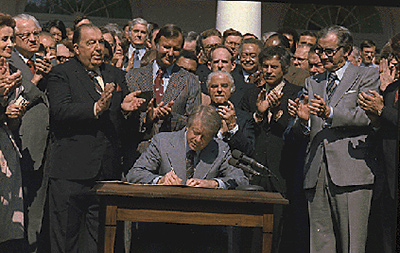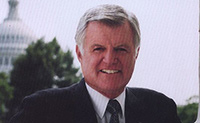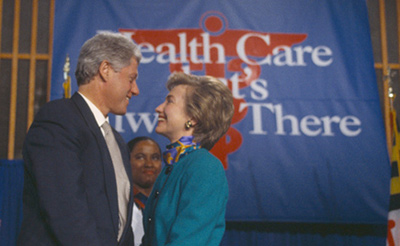Equal opportunity is the core American value that animates the American dream of upward mobility. All four presidents from Jimmy Carter to Bill Clinton whose administrations’ histories have been published as part of the Miller Center’s Presidential Oral History Program either faced a challenge or launched an initiative during their first year in office relating to the expansion of opportunity in the service of greater social and economic mobility.
These challenges and initiatives involved opportunity and mobility policies ranging from food stamps to AIDS to disability rights to health care reform. The range of cases below includes some issues that were foreseeable as early as the election campaign that brought the new president to office and others that arose unexpectedly after the inauguration. How the four presidents handled these situations illuminates the range of possibilities that any new chief executive may face.
The food stamp program (today called SNAP) was launched in 1964 on the premise that adequate nutrition is a prerequisite for seizing opportunities to advance in society. In Carter’s first year, a problem in the program’s design had become evident that he and his administration decided to fix. For a newly elected Democratic president entering office after eight years of Republican administrations, addressing a core Democratic program such as food stamps—especially one that he believed in deeply—was a matter of some urgency.
Secretary of Agriculture Robert Bergland: I think our [department’s] total budget was $25 billion or something, of which easily half went into feeding programs, school lunches, WIC, food stamps, and these things. Every year in Carter’s budget, that budget went up, on my recommendation and with his strong support. He believed in that. He figured it was the decent thing to do. On one occasion I provided him some documentation. So he saw the cost-benefit analysis. He was impressed by that, but that wasn’t what drove him. His instincts on these social programs were purely humanitarian. I think it was really his test. . . .

President Jimmy Carter chose to act in defiance of powerful congressional leadership to reform the Food Stamp Act because he believed that it was the right thing to do.
We had a problem in that there was a lot of cash that was transacted and would change hands. This person would get certified as being eligible for food stamps, but they have to put up 25 percent. So if they are eligible for $100 in food stamps, they had to come up with $25. . . .
What we wanted to do was get rid of the purchase requirement so that instead of this person paying $25 for this book of coupons and having all the trouble we had with handling that money that got stolen, we just say, “We will reduce your food stamp benefits. Instead of paying us $25 and getting a $100 book, you don’t pay us anything, and we’ll give you $75. . . .”
So we eliminated the cash. I went up to [House agriculture committee] Chairman [Tom] Foley and some of the people on the House side, and they’ve known about this purchase requirement problem for a long time. They said, “Yes, this makes sense. This is the smart thing to do.” I went over to see Chairman [Herman] Talmadge and the more conservative senators, and they just had a fit. They said, “What? You are going to give these things away free? Free food stamps? It’s a mistake. The president ought to have his head examined.” I said, “The president doesn’t know about this. . . .”
So I met with the president, and he looked over the evidence after he had read all the papers. He said, “Go ahead, we’ll take the heat.”
Part of Carter’s achievement in reforming the food stamp program involved a willingness to act in defiance of a powerful congressional leader, something that a first-year president may only be willing to do when it involves an important commitment that engages his or her core values.
HIV-AIDS was first diagnosed in the United States in 1981, during Reagan’s first year as president. Across the country, fears verging on panic were rampant about how the then-fatal disease was spread, with resulting discrimination against AIDS sufferers. The Reagan administration was criticized by many who felt that both the president and relevant agencies of the executive branch were slow to take the health crisis seriously because most of its victims were gay or lesbian. In time, federal research and prevention programs were launched, but a moment came when the president decided to use the symbolic authority of his office on behalf of the victims.
Secretary of Health and Human Services Otis Bowen: [The organizations] that gave me the most trouble were the AIDS groups thinking they were getting shortchanged all the time—even though the budget would go up and up and up. They had good points. It was a very, very serious thing, and I think, earlier, the administration didn’t think it was as important as it really was. . . . And in the AIDS area, you didn’t dare, in that administration, talk about the use of condoms. [T]he only program that the administration would permit was “Just don’t.”
White House physician John Hutton: The president had always been curious about the science of medicine, and wondered if our researchers were making any progress with identifying the infectious agent. I volunteered that Dr. [Robert] Gallo [of the National Institutes of Health] had isolated a hitherto unknown virus for which man seemed to have no defense.
The president replied, “You mean like the measles virus, but one that won’t go away, that arouses no immune response?” He understood my explanation and its implication.
I’m not sure with whom he discussed this disease entity, but he soon learned of the patients being studied at NIH, and of implications for panic from ignorance of how the disease was being spread. He asked if it would help with the awareness of the disease if he went out to NIH and visited with patients—especially with the children who had contracted the disease from their mothers.
How well I remember the afternoon when our motorcade took us to NIH, and we were escorted to the ward that housed these patients. He fully understood the routes of communicability of this disease, and in an effort to lend a calmness and understanding to the nation, he moved from room to room, visited with the mothers in his most congenial way, picked up the children as would any father, all to the satisfaction of the medical staff and photographers, and hopefully the curious and concerned citizens of our country.
Within a week an advisory committee was created, initially chaired by a member of the Mayo Clinic faculty and then by a former Chief of Naval Operations.
The president has attempted to enlighten the world about this threat, and at the same time to assuage their fears about the contagious nature of this most dangerous disease from which no one had yet survived.
Most presidential initiatives involve tangible action—legislation proposed, executive orders issued, or appointments made. Certainly the fight to address the AIDS crisis involved all of those things. But Reagan also showed that the power of the president to alleviate public fears through personal, highly visible conduct is important as well.
Removing barriers to full participation in American life for people with disabilities was one of Bush’s stated goals during his presidential campaign and his first year in office. Finding a way to achieve that goal without placing undue burdens on job-creating employers was the challenge. Working, sometimes contentiously, across party lines with Senator Edward M. Kennedy and others, Bush achieved passage of landmark legislation. The Americans with Disabilities Act (ADA) was enacted during Bush’s second year in office, but only because his administration had laid the foundation during his first year.
White House chief of staff John Sununu: This is a president that believes in a set . . . of fundamental conservative principles of minimizing government involvement, of free market, . . . and of a kinder, gentler (remember that phrase?) set of policies that deal with individual needs and recognizing that different people have different needs. That was the president’s broad philosophy. . . . It is embodied in ADA, recognizing that a segment of our society wasn’t able to participate because of handicaps and trying to give them an avenue to participate without creating a club or a sword that is used to hamper the capacity of the private sector to function . . .
[D]uring the election of ’88 [w]hat are we going to campaign on as domestic issues? . . . Campaigned on a concern for all Americans and out of that concern for all Americans grew, I think, his commitment to the civil rights bill and the ADA. . . .
[O]n the domestic side, there were two things that were a priority: Number one, let’s start doing something about the budget and the deficit, had to get a hold of that. And number two, start to create the interactions on issues . . . like civil rights and ADA, that gets us to the point where we get them passed. We may not pass them this year, but you have to start this year. . . .
The first ADA bill looked like it had 110 senators supporting it out of a hundred. Nobody had read anything but the title and how could you vote “no” for a piece of legislation called the Americans with Disabilities Act? But the first bill was terrible, the first draft. It created about a hundred new entitlements, slight exaggeration but only slight.
Senator Edward M. Kennedy, chairman of the Senate education and labor committee: I asked to go down to see his chief of staff, John Sununu. It was in the late summer, and he was decent to see me, but he was very abrupt and to the point. He said, “Look, we’re not going to support any social legislation. . . .”
But Bush walked by where we were, and I asked if I could go in and see him. He said fine. I went in. . . . And I said why I was down here, and he said, “Well, that’s of some interest to me, and I’ll talk to John further about it. . . .”

Senator Edward Kennedy worked with President George H.W. Bush to pass the Americans with Disabilities Act by focusing on “reasonable accommodations.”
I went down to see Sununu some weeks later; this was when we sat in his office and he said, . . . “What is this going to mean in New Hampshire at the Sunapee Ski Resort? Somebody comes up in a wheelchair and wants to be able to go to the top of the mountain. What are we going to have to do? Are we going to have to retrofit every chair?” I said, “No, no we’re not going to have to do that.” He said, “What are we going to have to do?”
I said, “We’re going to have to make reasonable accommodation.” He said, “Well, what’s reasonable—every tenth, every hundredth?” I said, “We make the decision based on how many people in wheelchairs want to go, what the cost is. It’s going to have to be reasonable.”
Sununu: It was a very hard kind of negotiations because . . . we’re struggling to build into it provisions that the business community was desperately coming to us with concerns about. But over time it evolved, and it evolved primarily because of the chairman, Kennedy.
Kennedy: One of the final meetings we had on disability—now that it was all worked out, and the Republicans wanted to get their stamp on it—was with [Senate Republican leader Bob] Dole up in his leadership office.
Dole: [ADA is] a great piece of civil rights legislation. . . . I had a strong interest because of my disability. . . . [Attorney General Richard] Thornburgh has a son, of course, who had a very severe disability.

President George H.W. Bush signed the Americans with Disabilities Act in 1990, after laying the foundation for passing the legislation during his first year in office.
Thornburgh: The ADA act was signed on July 26, 1990. . . . and it was a triumphant day when that bill was signed. . . . And the president’s speech was marvelous. He ended it with a call, “To let these shameful walls of exclusion finally come tumbling down,” a reference to the Berlin Wall. It was neat, a good exercise. That’s the way the system ought to work.
Bridging partisan divides is never easy in Washington. But the likelihood of success is greater when, as with the rights of the disabled, the issue is not one that traditionally separates the parties and when the work of coalition-building begins in the first year, with the midterm election still a year away and the next presidential election three years in the future.
Not every first-year initiative is successful. Clinton’s ambitious plan to extend health care to all as a necessary condition for economic advancement and social mobility was grounded in his oft-stated governing values of “opportunity, responsibility, and community.” But it foundered on the shoals of complexity traceable in part to the flawed legislative design process he created.
Deputy Domestic Policy Adviser Bruce Reed: [In our first year] we wanted to flood the circuits. We figured that Congress would slow-walk enough things as it was, so that we didn’t have to make it any easier for them. One of the areas where we ran into the most difficulty was that the congressional system is not well set up to handle a couple of high priorities at the same time. Bill Clinton actually wanted to pursue welfare reform and health care at the same time, because he felt that they were intrinsically related as policy and that they spoke to different anxieties of the electorate. Unfortunately, they went through the same committees. And even worse, the House wanted to do health care and not welfare reform, and the [Senate] Finance Committee wanted to do welfare reform and not health care.
Health care economics advisor David Cutler: [There] was a fateful meeting on health care [during the transition] in Little Rock . . . It’s with the president. The First Lady is there. She sat in the back of the room, quiet.
Secretary of Health and Human Services Donna Shalala: It’s a famous meeting because . . . the president talked about how he was going to run the health care reform process with his own staff [rather than my department].
There was no way I could turf fight over that. . . . It was screwy, but when the president and the First Lady decide they want to do something first on, unless it’s illegal you support it.
Health care advisor Chris Jennings: I think in fairness it was more of an illustration of the importance of the issue to the president, I think, on Capitol Hill and elsewhere. “Well gee, he’s willing to put her out there and put their capital on the line. He must really care about this issue.”

President Bill Clinton worked to reform health care from within the White House, led by First Lady Hillary Clinton. However, the reform effort was ultimately unsuccessful.
Deputy domestic policy advisor William Galston: To be direct—the way the leadership of that effort was constituted did not invite a lot of vocal dissent. If you really wanted to screw up things with the First Lady (and arguably with the president as well), expressing doubts about the health care process or its product was a damn good way to go about it.
Council of Economic Advisers member Alan Blinder: Anyway, the idea was to bundle the health care reform into [the congressional budgetary] reconciliation [process], on the grounds that you needed only 51 votes and that might be the only way they could get the health care bill through the Congress. . . . one humongous bill that can’t be filibustered.
As one, to a man and woman, the economic team went nuts over that idea, for a variety of reasons. But the simplest of which, and the most compelling to me, was there was no way in hell we were going to have a health care plan ready by the middle of February [1993, when Congress would be acting].
OMB Director Leon Panetta: I can remember spending a lot of time in the [First Lady’s health care] task force saying, “You’ve got to have a simple way to explain things, and it’s not just to the American people, but to a member of Congress. If you take more than two sentences to explain what’s in a piece of legislation, chances are you’re going to lose them.” I kept saying, “This thing is like a Rubik’s Cube in the sense that no matter how you talk it through, you become so immersed in the detail of it that you can’t say, ‘What does this mean for the average citizen on the street in terms of what the impact is going to be?’”
Council of Economic Advisers member David Cutler: Even if you look at when the president gave his speech in September [1993], he said there were six principles—not three, not one, not two, but six. Nobody will remember six principles.
Clinton’s campaign for health care reform helped prepare the way for passage of the Affordable Care Act 16 years later. In that sense, it was successful but premature. But as a first-year initiative in 1993, it was hobbled in several ways by the president’s haste to get things done, which led him to develop the proposal within the White House without adequate departmental consultation, overwhelm a crowded congressional agenda, and fail to arrive at clear and comprehensible ways of explaining a very complex program to the American people.